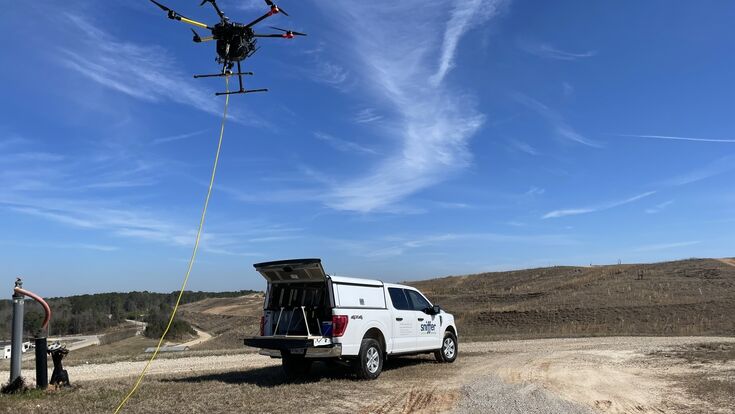Landfill emissions : Drones monitor landfill methane emissions

Greenhouse Gases actually come with a cost. According to a Draft Report on the Social Cost of Greenhouse Gases presented last November by the US Environmental Protection Agency (EPA) the estimated social cost of methane due to the future impacts of climate change is $1,600/metric ton. Since landfill gas – a byproduct of waste decomposition – is generally composed of 50% odorless methane, and 50% carbon dioxide, with trace amounts of odorous gases such as hydrogen sulfide (H2S) and other volatile organic compounds (VOCs), this cost translates to landfill methane emissions' overall societal cost of over $136 billion annually.
Capturing landfill gas
The waste industry makes an effort to either prevent emissions or capture landfill gas. Most of this gas can be cleaned and converted to electricity (Landfill Gas to Energy) or processed into Renewable Natural Gas (RNG or biomethane). Nevertheless, a portion is emitted into the atmosphere. Emissions are generally attributed to insufficient gas collection, poor cover, and/or lack of maintenance, and can also be attributed to weather and environmental conditions. According to the US EPA, over 85 million metric tons of methane was emitted from the waste industry in the United States in 2021 making it the third largest industry for methane emissions.
But not only that. Methane emissions that could be collected and converted to energy is basically lost revenue to the industry. An estimated $6 billion annually based on a Renewable Natural Gas (RNG) valuation.
Drone-based landfill monitoring
Furthermore, the US EPA requirements for municipal solid waste landfills require remediation of methane concentrations above 500 ppm. To better monitor landfill gas emissions, the industry relies more and more on new aerial technologies such as satellites, manned aircraft, and other drone-based technologies. Among the latter is the SnifferDRONE system by environmental technology-enabled service firm Sniffer Robotics which just got approved by US EPA as the first drone-based solution for emissions monitoring.
“The SnifferDRONE's solution is unique in collecting air samples directly at the ground surface, measuring methane concentrations within collected air samples in parts per million (ppm) and correlating measurements to discrete latitude/longitude coordinates during flight,” explains Arthur Mohr, Sniffer Robotics' CEO. This data is then transformed into specific leak locations consistent with EPA regulations as actionable information. The data can also be transformed to estimate fugitive gas emissions and analyzed to understand site gas migration in conjunction with operational changes. According to Mohr, the drone can be operated by a pilot after minor training.
To adhere to EPA regulations, surface emissions monitoring for landfills must be performed along a serpentine path with no more than 30-meter spacing. The SnifferDRONE is flown along pre-programmed flight paths designed following the regulatory requirements. During the flight the pilot can deviate from the flight path to inspect indicative areas, then return to the pre-programmed flight path to complete the mission.
“Other aerial technologies can detect methane but it is important to note that these technologies are really focused on quantifying the emissions (kg/hr) without precisely identifying leak locations", Mohr adds. "Our technology instead is a bottoms up approach where we are able to first identify leak sources based on methane concentrations (ppm) from which emissions can also be quantified."
“The SnifferDRONE is able to detect methane leaks with a >90% accuracy within 35’ from the reported GPS coordinates,” Mohr says about the advantages of the system. “This is extremely important since these leaks need to be remediated – in the US within 30 days. Other aerial technologies can detect methane but it is important to note that these technologies are really focused on quantifying the emissions (kg/hr) without precisely identifying leak locations", Mohr adds. "Our technology instead is a bottoms up approach where we are able to first identify leak sources based on methane concentrations (ppm) from which emissions can also be quantified. So we are able to precisely and accurately identify leaks and do so efficiently and more safely than having a technician who otherwise would be walking the landfill surface.”
As of now, the system is only available in the US, however later in 2023 the company intends to introduce it to the European market.

